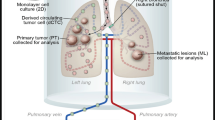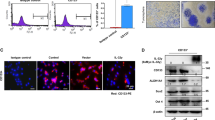Abstract
The side population (SP) in human lung cancer cell lines and tumors is enriched with cancer stem cells. An endogenous inhibitor of angiogenesis known as tissue inhibitor of matrix metalloproteinase-2 (TIMP-2), characterized for its ability to inhibit matrix metalloproteinases (MMPs), has been shown by several laboratories to impede tumor progression through MMP-dependent or -independent mechanisms. We recently reported that forced expression of TIMP-2, as well as the modified form Ala+TIMP-2 (that lacks MMP inhibitory activity) significantly blocks growth of A549 human lung cancer cells in vivo. However, the mechanisms underlying TIMP-2 antitumor effects are not fully characterized. Here, we examine the hypothesis that the TIMP-2 antitumor activity may involve regulation of the SP in human lung cancer cells. Indeed, using Hoechst dye efflux assay and flow cytometry, as well as quantitative reverse transcriptase–PCR analysis, we found that endogenous TIMP-2 mRNA levels showed a significant inverse correlation with SP fraction size in six non-small cell lung cancer cell lines. In A549 cells expressing increased levels of TIMP-2, a significant decrease in SP was observed, and this decrease was associated with lowered gene expression of ABCG2, ABCB1 and AKR1C1. Functional analysis of A549 cells showed that TIMP-2 overexpression increased chemosensitivity to cytotoxic drugs. The SP isolated from TIMP-2-overexpressing A549 cells also demonstrated impaired migratory capacity compared with the SP from empty vector control. More importantly, our data provide strong evidence that these TIMP-2 functions occur independent of MMP inhibition, as A549 cells overexpressing Ala+TIMP-2 exhibited identical behavior to those overexpressing TIMP-2 alone. Our findings provide the first indication that TIMP-2 modulates SP phenotype and function, and suggests that TIMP-2 may act as an endogenous suppressor of the SP in human lung cancer cells.
This is a preview of subscription content, access via your institution
Access options
Subscribe to this journal
Receive 50 print issues and online access
$259.00 per year
only $5.18 per issue
Buy this article
- Purchase on Springer Link
- Instant access to full article PDF
Prices may be subject to local taxes which are calculated during checkout




Similar content being viewed by others
References
Heppner GH, Miller BE . Tumor heterogeneity: biological implications and therapeutic consequences. Cancer Metastasis Rev 1983; 2: 5–23.
Vermeulen L, Sprick MR, Kemper K, Stassi G, Medema JP . Cancer stem cells—old concepts, new insights. Cell Death Differ 2008; 15: 947–958.
Visvader JE, Lindeman GJ . Cancer stem cells in solid tumours: accumulating evidence and unresolved questions. Nat Rev Cancer 2008; 8: 755–768.
Wu C, Alman BA . Side population cells in human cancers. Cancer Lett 2008; 268: 1–9.
Goodell MA, Brose K, Paradis G, Conner AS, Mulligan RC . Isolation and functional properties of murine hematopoietic stem cells that are replicating in vivo. J Exp Med 1996; 183: 1797–1806.
Shimano K, Satake M, Okaya A, Kitanaka J, Kitanaka N, Takemura M et al. Hepatic oval cells have the side population phenotype defined by expression of ATP-binding cassette transporter ABCG2/BCRP1. Am J Pathol 2003; 163: 3–9.
Lopez J, Poitevin A, Mendoza-Martinez V, Perez-Plasencia C, Garcia-Carranca A . Cancer-initiating cells derived from established cervical cell lines exhibit stem-cell markers and increased radioresistance. BMC Cancer 2012; 12: 48.
Mitsutake N, Iwao A, Nagai K, Namba H, Ohtsuru A, Saenko V et al. Characterization of side population in thyroid cancer cell lines: cancer stem-like cells are enriched partly but not exclusively. Endocrinology 2007; 148: 1797–1803.
Szotek PP, Pieretti-Vanmarcke R, Masiakos PT, Dinulescu DM, Connolly D, Foster R et al. Ovarian cancer side population defines cells with stem cell-like characteristics and Mullerian Inhibiting Substance responsiveness. Proc Natl Acad Sci USA 2006; 103: 11154–11159.
Kondo T, Setoguchi T, Taga T . Persistence of a small subpopulation of cancer stem-like cells in the C6 glioma cell line. Proc Natl Acad Sci USA 2004; 101: 781–786.
Ho MM, Ng AV, Lam S, Hung JY . Side population in human lung cancer cell lines and tumors is enriched with stem-like cancer cells. Cancer Res 2007; 67: 4827–4833.
Szakacs G, Paterson JK, Ludwig JA, Booth-Genthe C, Gottesman MM . Targeting multidrug resistance in cancer. Nat Rev Drug Discov 2006; 5: 219–234.
Zhou S, Schuetz JD, Bunting KD, Colapietro AM, Sampath J, Morris JJ et al. The ABC transporter Bcrp1/ABCG2 is expressed in a wide variety of stem cells and is a molecular determinant of the side-population phenotype. Nat Med 2001; 7: 1028–1034.
Ding XW, Wu JH, Jiang CP . ABCG2: a potential marker of stem cells and novel target in stem cell and cancer therapy. Life Sci 2010; 86: 631–637.
Dean M . ABC transporters, drug resistance, and cancer stem cells. J Mammary Gland Biol Neoplasia 2009; 14: 3–9.
An Y, Ongkeko WM . ABCG2: the key to chemoresistance in cancer stem cells? Expert Opin Drug Metab Toxicol 2009; 5: 1529–1542.
Seo DW, Li H, Guedez L, Wingfield PT, Diaz T, Salloum R et al. TIMP-2 mediated inhibition of angiogenesis: an MMP-independent mechanism. Cell 2003; 114: 171–180.
Fernandez CA, Butterfield C, Jackson G, Moses MA . Structural and functional uncoupling of the enzymatic and angiogenic inhibitory activities of tissue inhibitor of metalloproteinase-2 (TIMP-2): loop 6 is a novel angiogenesis inhibitor. J Biol Chem 2003; 278: 40989–40995.
Fernandez CA, Roy R, Lee S, Yang J, Panigrahy D, Van Vliet KJ et al. The anti-angiogenic peptide, loop 6, binds insulin-like growth factor-1 receptor. J Biol Chem 2010; 285: 41886–41895.
Bourboulia D, Jensen-Taubman S, Rittler MR, Han HY, Chatterjee T, Wei B et al. Endogenous angiogenesis inhibitor blocks tumor growth via direct and indirect effects on tumor microenvironment. Am J Pathol 2011; 179: 2589–2600.
Seo DC, Sung JM, Cho HJ, Yi H, Seo KH, Choi IS et al. Gene expression profiling of cancer stem cell in human lung adenocarcinoma A549 cells. Mol Cancer 2007; 6: 1–8.
Sung JM, Cho HJ, Yi H, Lee CH, Kim HS, Kim DK et al. Characterization of a stem cell population in lung cancer A549 cells. Biochem Biophys Res Commun 2008; 371: 163–167.
Akunuru S, Palumbo J, Zhai QJ, Zheng Y . Rac1 targeting suppresses human non-small cell lung adenocarcinoma cancer stem cell activity. PloS One 2011; 6: e16951.
Salcido CD, Larochelle A, Taylor BJ, Dunbar CE, Varticovski L . Molecular characterisation of side population cells with cancer stem cell-like characteristics in small-cell lung cancer. Br J Cancer 2010; 102: 1636–1644.
Fletcher JI, Haber M, Henderson MJ, Norris MD . ABC transporters in cancer: more than just drug efflux pumps. Nat Rev Cancer 2010; 10: 147–156.
Yoh K, Ishii G, Yokose T, Minegishi Y, Tsuta K, Goto K et al. Breast cancer resistance protein impacts clinical outcome in platinum-based chemotherapy for advanced non-small cell lung cancer. Clin Cancer Res 2004; 10: 1691–1697.
Deng HB, Adikari M, Parekh HK, Simpkins H . Ubiquitous induction of resistance to platinum drugs in human ovarian, cervical, germ-cell and lung carcinoma tumor cells overexpressing isoforms 1 and 2 of dihydrodiol dehydrogenase. Cancer Chemother Pharmacol 2004; 54: 301–307.
Wanichwatanadecha P, Sirisrimangkorn S, Kaewprag J, Ponglikitmongkol M . Transactivation activity of human papillomavirus type 16 E6*I on AKR1C enhances chemoresistance in cervical cancer cells. J Gen Virol 2012; 93: 1081–1092.
Halon A, Nowak-Markwitz E, Donizy P, Matkowski R, Maciejczyk A, Gansukh T et al. Enhanced immunoreactivity of TIMP-2 in the stromal compartment of tumor as a marker of favorable prognosis in ovarian cancer patients. J Histochem Cytochem 2012; 60: 491–501.
Stetler-Stevenson WG . The tumor microenvironment: regulation by MMP-independent effects of tissue inhibitor of metalloproteinases-2. Cancer Metastasis Rev 2008; 27: 57–66.
Acknowledgements
We thank the Laboratory of Molecular Technology, NCI Frederick for the microarray experiment. We also thank the members of the Extracellular Matrix Pathology Section, Radiation Oncology Branch, NCI for critical discussions. This work was supported by the NCI Center for Cancer Research Intramural Research Grant # ZIA SC009179-22.
Author information
Authors and Affiliations
Corresponding author
Ethics declarations
Competing interests
The authors declare no conflict of interest.
Additional information
Supplementary Information accompanies this paper on the Oncogene website
Supplementary information
Rights and permissions
About this article
Cite this article
Han, H., Bourboulia, D., Jensen-Taubman, S. et al. An endogenous inhibitor of angiogenesis inversely correlates with side population phenotype and function in human lung cancer cells. Oncogene 33, 1198–1206 (2014). https://doi.org/10.1038/onc.2013.61
Received:
Revised:
Accepted:
Published:
Issue Date:
DOI: https://doi.org/10.1038/onc.2013.61
Keywords
This article is cited by
-
Molecular mechanisms of tissue inhibitor of metalloproteinase 2 in the tumor microenvironment
Molecular and Cellular Therapies (2014)



